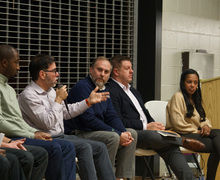Syracuse unemployment hits record low, but experts remain skeptical
Delaney Kuric | Head Illustrator
The Syracuse-metro area unemployment rate went down to 4.5 percent last month compared to 5 percent last year, according to a Department of Labor report published Sept. 20.
The Syracuse metro area’s unemployment rate recently hit a record low, but some are skeptical of whether the number reflects the actual situation.
The unemployment rate went down to 4.5 percent last month compared to 5 percent last year, according to a Department of Labor report published Sept. 20.
But Carl Schramm, a Syracuse University professor specializing in labor economics, said the statistic is an insufficient reflection of the state of any local economy’s labor market, since it only measured the percentage of people currently looking for work that do not have jobs.
“Local unemployment numbers must be considered in conjunction with the number of people who make up the potential fully employed local labor force,” Schramm said. “Some share of which has permanently given up looking for work.”
Workers who voluntarily leave the labor market for various reasons are called “discouraged workers.”
Another important concept is the labor force participation rate, Schramm said, which is the number of currently employed people or those who are actively searching for work as a percentage of all those who could and would work if there were jobs.
Schramm pointed out Syracuse’s LFPR is only 47 percent, compared to the national 62 percent, despite the unemployment rate decrease.
It is important to consider both the unemployment rates and the LFPR against the total economic growth rates, which since the great recession have continued at rates of less than 1.5 percent annually, Schramm said. Doing so will make it easier to make sense of some of those seemingly-conflicting numbers.
Common Councilor Khalid Bey said his first reaction to the report was “skepticism.”
“There has been little increase in job creation within the city,” Bey said. “Most jobs created in the past year or more have been created outside of the city. The few jobs that were created in the city had strict requirements, which essentially disqualified many city residents.”
Further complicating the state of Syracuse’s economy and labor market is the fact that the report by the Department of Labor came out just five days after a report by the U.S. Census Bureau ranked Syracuse as the No. 29 poorest city in America.
Bey said this was because the numbers presented for the unemployment rate are for the Syracuse metro area, not the city of Syracuse, whereas the report about concentrated poverty included neighborhoods within the city.
Despite this, Bey said he would describe the economy of central and upstate New York as “recovering.” He also added that for significant progress to be made overall, the urban centers must be strengthened.
“I’m always optimistic about our potential to attract new work opportunities for city residents,” Bey said. “I would expect that circumstances will improve.”
Published on September 30, 2016 at 6:30 pm
Contact BreeAnna: blposhek@syr.edu





